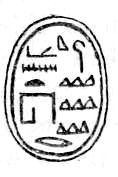Anat-her
Anat-her
Ancient Egyptian king
Anat-her (also 'Anat-Har) may have been the first ruler of the Sixteenth Dynasty of Egypt, reigning over some part of Lower Egypt during the Second Intermediate Period as a vassal of the Hyksos kings of the 15th Dynasty.[2][3] This is contested however, with the Egyptologists Kim Ryholt and Darrel Baker believing that 'Anat-Har was a Canaanite chieftain contemporary with the powerful 12th Dynasty.[4] Others such as Nicholas Geoffrey Lempriere Hammond contend that he was a prince of the 15th Dynasty.[5] 'Anat-Har's name means "Anat is content" and refers to the Semitic goddess Anat, showing that he was of Canaanite descent.
